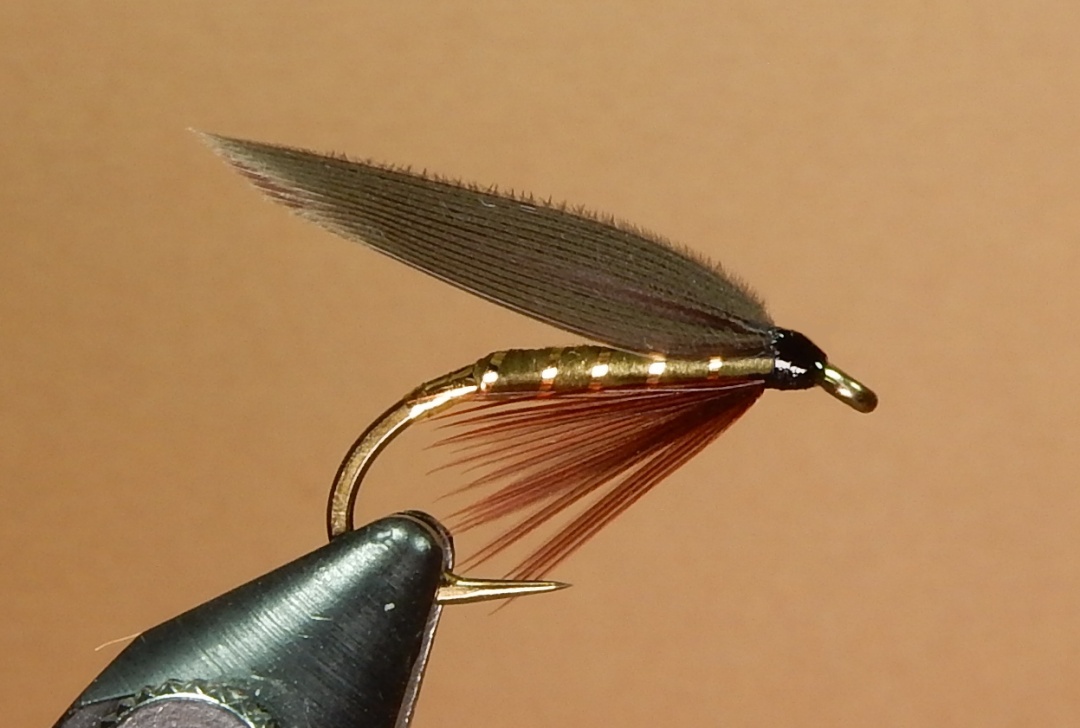
Greenwell's Glory
Winged Wet Fly
Tag - Gold tinsel
Ribbing - Gold tinsel
Body - Olive floss
Hackle - Dark brown furnace
Wing - Very dark slate
Trout - Ray Bergman
Forgotten Flies - Schmookler and Sils

I hope that people that tie ordinary flies for everyday fishing won't be too intimidated by the Art Flies that have become so predominant on the fly tying pages. As beautiful as the flies are they don't represent what is needed for daily fishing where you might lose a dozen flies a day under normal circumstances. I for one have been intimidated by page after page of complex brilliantly colored flies that are museum quality but lack practicality. I would like to see more fishable flies that would be at home in area lakes and streams and particularly flies that those of us with modest skills can readily tie. I admire the skill it takes to tie the Art Flies but in the end get more out of watching a guy on YouTube tie a Perdigon nymph or a caddis pupa that I can use locally.
And yes-I realize that my remarks will generate some criticism...
...Yes, shadow box flies are great and a wonderful example of the art, but I tie my flies for the fish. "Goodnuf"; is my standard. Plus, shadow boxes make a hell of a splash when you cast them on the water
Seems they use different types of flies up NorthCoho buggers for fresh water (stolen from the Canadians on YouTube
5/32” gold bead
#8 hook 2L
Tail- Pearl flashibou on the bright one
Olive bunny on the dark one
Body- hackle chenille spun and palmered
Comment- I’m not sure how tightly you need to spin these
View attachment 54127
View attachment 54128
View attachment 54129
I like scruffy "could be any number of bugs" easy to tie flies!I hope that people that tie ordinary flies for everyday fishing won't be too intimidated by the Art Flies that have become so predominant on the fly tying pages. As beautiful as the flies are they don't represent what is needed for daily fishing where you might lose a dozen flies a day under normal circumstances. I for one have been intimidated by page after page of complex brilliantly colored flies that are museum quality but lack practicality. I would like to see more fishable flies that would be at home in area lakes and streams and particularly flies that those of us with modest skills can readily tie. I admire the skill it takes to tie the Art Flies but in the end get more out of watching a guy on YouTube tie a Perdigon nymph or a caddis pupa that I can use locally.
And yes-I realize that my remarks will generate some criticism......
I like 'em all!I like scruffy "could be any number of bugs" easy to tie flies!
If I fished trout all day and every day, that might be one of the flies that would always be in my box. Those things just flat out work. I really like how you tie it....
My very first attempt at using pheasant tail…next black pheasant tail. Then I’m going to try my first deer hair fly…just tying flies I want to useIf I fished trout all day and every day, that might be one of the flies that would always be in my box. Those things just flat out work. I really like how you tie it....
You should do the 2x2 fly swap, it's all easy flies using 2 materials.My very first attempt at using pheasant tail…next black pheasant tail. Then I’m going to try my first deer hair fly…just tying flies I want to use
Nice ties guy's. I have similar flies, but for the life of me I can't get the fish to eat them.
From what I’ve seen the fish are too busy eating your other fliesNice ties guy's. I have similar flies, but for the life of me I can't get the fish to eat them.
Maybe. When I fish them with other flies, no matter the dropper position, the other flies get hit. I've tried them alone several times this winter because it's supposed to be a good whitefish fly, but I think I've only got 1 or 2 fish on them.From what I’ve seen the fish are too busy eating your other flies
Sometimes they see a particular fly, especially if it’s a size larger than the other fly, then eat the smaller/other one…I tied the pheasant tails in 14, and will fish them with a 16 or 18 nymph…Maybe. When I fish them with other flies, no matter the dropper position, the other flies get hit. I've tried them alone several times this winter because it's supposed to be a good whitefish fly, but I think I've only got 1 or 2 fish on them.